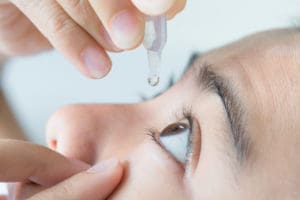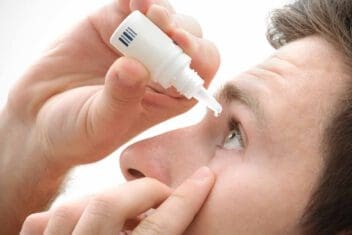What Are the Best Eye Drops for Dry Eyes?
Home / Dry Eyes: Causes, Symptoms & Treatments /
Last Updated:
There are many types of eye drops that can help dry eyes.
Table of Contents
Some, like cyclosporine and lifitegrast, are only available by prescription. Others are available over the counter, such as artificial tears and allergy drops. As a general rule, prescription medications tackle bigger dryness issues but come with more side effects.
If your eye dryness isn’t too serious, artificial tears or allergy drops should be enough to resolve your issue. Some lifestyle changes can help as well.
If your problem is serious or long lasting, you should talk to a doctor. They can help you find exactly the right drops for you, and they can authorize prescription drops if appropriate.
Not all eye drops will interact well with contact lenses. If you wear contacts, do not get eye drops with preservatives in them. If your eyes are irritated, it can be a good idea to temporarily stop wearing contacts since they may be exacerbating the issue.
Dry Eyes & Eye Drops

Dry, itchy, irritated eyes can be extremely uncomfortable. It can be a bit overwhelming to try and figure out how to approach fixing them. While you should see a doctor if you experience dry eyes for more than a day or two, there are solutions that can work from home — primarily eye drops.
As anyone who has looked into it knows, there are a variety of eye drops to choose from. Putting aside the obviously wrong fits (that almost exclusively are only available by prescription or from a doctor) like dilating drops, antibiotic drops (assuming your dryness isn’t due to an infection), and the like, there are a few varieties that need to be considered.
Here are some options for combating dry eyes:
- Artificial tears/lubricating eye drops: Artificial tears are probably the most common solution to dry eyes. There are dozens of brands available, including many generics. The idea behind artificial tears is simple — it’s just a sterile solution to safely moisten the eye. Side effects tend to be minimal, but you should still follow the directions on the back of the box. You may need to experiment with several different brands to find the one that works best for you.
- Allergy drops: This is another type of medication that comes in a plethora of brands. Allergy drops come in many forms, including antihistamines and newer mast-cell stabilizers. They all target the same basic processes, even if the approach is slightly different. The idea behind allergy drops is to stop the allergy symptoms that are causing your dry eyes or other eye symptoms.
- Decongestant drops: These drops can temporarily help with redness, although they should be used with caution. If they are used for too long, they can actually worsen symptoms. With long-term use, your eyes can grow dependent on them, and symptoms get worse when you stop using them. Many experts recommend avoiding these drops if you have dry eyes.
- Cyclosporine (Restasis): This prescription-grade eye drop medication helps your eyes produce more tears. It is used to treat chronic dry eye caused by inflammation. Side effects can include irritation of the eye, such as redness and itchiness, visual blurring, excessive tearing, discharge, and more. It is generally only prescribed for serious cases where the benefits outweigh the risk of uncomfortable side effects.
- Lifitegrast (Xiidra): A type of medication called an LFA-1 antagonist, lifitegrast is a prescription eye drop that is meant to treat dry eye disease by reducing swelling of the eye tissue. Side effects can include eye irritation, visual blurring, excessive tearing, and discharge (as is typical of many types of prescription eye drops). Additional side effects can include headache, stuffy nose, throat irritation, pain or pressure in the face, and changes to your sense of taste. You should always use it as instructed and only when your doctor thinks it is a good fit.
- Autologous blood serum: This is generally only used in severe cases where other methods are proving ineffective. Autologous blood serum is a special eye solution prepared using the patient’s own blood and a salt solution. Autologous blood serum has been shown to improve tear film stability and subjective comfort in patients, although some argue the evidence of its effectiveness is not where it needs to be to fully recommend it yet.
Which Eye Drops Are Best for Me?

Putting aside decongestant drops since they generally aren’t a good fit for dry eyes, you are still left with many options when trying to combat dry eyes.
It’s advisable to talk to a doctor if you are struggling with dry eyes, so you can get the best solution to your problem. A doctor can assess underlying conditions that need to be treated and also prescribe medications if they are needed.
You deserve clear vision. We can help.
With 135+ locations and over 2.5 million procedures performed, our board-certified eye surgeons deliver results you can trust. Your journey to better vision starts here.
If your problem isn’t especially severe, it is likely that artificial tears will suffice. If your problem is caused by allergies, use allergy drops.
You may need to try a few different types of medication to find one that works for you. If your symptoms remain after a few weeks, talk to a doctor. Chronic dry eyes could be the sign of a more serious problem, such as diabetes, lupus, or rheumatoid arthritis. You don’t want to endanger your vision by waiting to get professional help.
How Much Do Eye Drops Cost?
Lubricating Eye Drops
Lubricant eye drops (ocular lubricant ophthalmic) are an affordable treatment option for dry eye syndrome. Depending on the pharmacy you visit, the price of generic lubricant eye drops ranges from:
- $12 to $14 for 15 ml
- $14 to $16 for 30 ml
- $18 for 50 ml
Generally in the price ranges you should expect to pay on the lower end of the range. Stock shortages and other variables move the prices towards the higher end of the range.
Brand-name versions cost slightly more than the generic versions. You can purchase brand-name versions of lubricating eye drops from online platforms.
Allergy Eye Drops
Most allergy eye drops contain ketotifen as the primary active ingredient. These specific drops are effective for treating some symptoms of dry eyes, such as itching, caused by allergies.
In this group, allergy eye drops with 0.025% of ketotifen cost between $5 and $13, depending on your pharmacy.
Cyclosporine (Restasis)
Cyclosporine is a prescription-only ophthalmic anti-inflammatory drug used to treat serious dry eye syndrome cases. The price of 0.1% cyclosporine ophthalmic emulsion is about $140 (around $8 per unit) for a supply of 16.5 milliliters.
Again, costs can vary by pharmacy. A one-month supply of cyclosporine costs about $530, and this is a single 5.5 ml bottle.
Lifitegrast (Xiidra)
Lifitegrast is a prescription-only treatment option that is more costly than over-the-counter alternatives, including lubricant eye drops and artificial tears. Lifitegrast ophthalmic solution 5% (Xiidra) costs about $530 for a one-month supply. A carton contains 60 single-use ampules
Other Treatments for Dry Eyes
According to the American Academy of Ophthalmology (AAO), dry eye syndrome affects about 4.88 million people over 50 years old in the United States. Typical treatment involves eye drops and medications to keep your eyes moist.
An effective approach involves minimizing or eliminating environmental triggers. Doctors often look for underlying causes such as vitamin deficiency, diabetes and glandular problems to treat or manage, after which the symptoms usually resolve.
Another viable option involves punctal plugs. These are special plugs fitted into the opening of the tear ducts(puncta). They help keep tears in your eyes for longer, thus relieving dry eyes.
In very rare cases, when punctal plugs and medications fail, a doctor can recommend a surgical procedure called cauterization. This is a permanent solution whereby the ophthalmologist utilizes heat to close the puncta permanently, preventing tears from draining out of your eyes.
You deserve clear vision. We can help.
With 135+ locations and over 2.5 million procedures performed, our board-certified eye surgeons deliver results you can trust. Your journey to better vision starts here.
Note to Contact Users
Not all eye drops go well with contacts. It’s wise to talk to an optometrist or ophthalmologist about which drops work best for your eyes if you wear contact lenses. You will need to avoid any eye drops with preservatives, as they can interact poorly with your contacts and cause problems.
It’s often best to avoid wearing contacts until your dry eyes resolve. Contacts can irritate the eye further, so it’s wise to switch to glasses for a few days.
Lifestyle Changes
In addition to eye drops, there are various lifestyle changes that can help to alleviate dry eyes.
- Rest your eyes. If you regularly work at a computer, make sure to take sufficient breaks. Look at something in the distance every 20 minutes to give your eyes a break.
- Wear sunglasses. Opt for wraparound sunglasses that protect your eyes from wind, which can further dry out your eyes.
- Assess your air conditioning. Reposition your car’s AC vents so they aren’t pointed at your eyes. Turn down the AC in your home or office a bit to avoid air that is too dry.
- Use a humidifier. This can moisten the air, providing a more welcoming environment for your eyes.
- Try warm compresses. These can release oil buildup in the tear glands, which helps to improve the quality of tears and lessen dry eyes.
- Consider your medications. Various medications can cause dry eyes as a side effect. Talk to your doctor about the medications you take and whether they could be contributing to your dry eyes.
You deserve clear vision. We can help.
With 135+ locations and over 2.5 million procedures performed, our board-certified eye surgeons deliver results you can trust. Your journey to better vision starts here.
References
- Eye Drops. (July 2018). American Academy of Ophthalmology.
- Which Eye Drops Are Best for Dry Eyes? Medical News Today.
- Restasis. (May 2019). RxList.
- Lifitegrast Ophthalmic. (September 2016). MedlinePlus.
- Do You Use the Right Eye Drops for Your Dry Eyes? (June 2019). WebMD.
- Re-think Autologous Serum. (October 2018). Review of Optometry.
- Allergy Eye Drops: Which Ones Will Bring You Relief? (August 2019). All About Vision.
- Eye Health Statistics. (2015). American Academy of Ophthalmology.
- Ocular lubricant ophthalmic Prices, Coupons and Patient Assistance Programs. (2021). Drugs.com.
- Allergy Eye Drops. (2020). ScriptSave WellRx.
- Lifitegrast Ophthalmic Solution 5% (Xiidra) for Dry Eye Disease. (July 15, 2018). American Family Physician.
- Cyclosporine ophthalmic Prices, Coupes and Patient Assistance Programs. (2021). Drugs.com.
- Punctal Plugs. (May 26, 2021). American Academy of Ophthalmology.
- Minimally Invasive Procedures for Dry Eye Syndrome. (2021). NYU Langone Health.
This content is for informational purposes only. It may have been reviewed by a licensed physician, but is not intended to serve as a substitute for professional medical advice. Always consult your healthcare provider with any health concerns. For more, read our Privacy Policy and Editorial Policy.